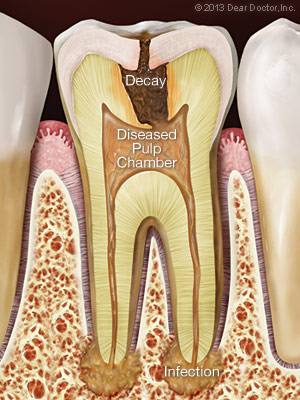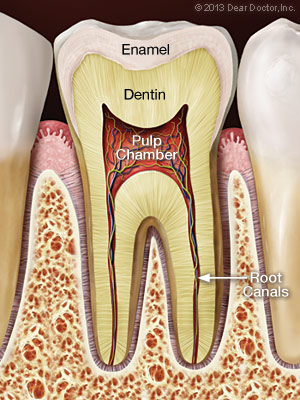July 15, 2016
If you're about to have your first root canal treatment, you might be feeling pretty apprehensive about the whole thing, especially given all the stories floating around. Well, don't worry — all will be revealed in this step-by-step walk-through of root canal treatment. Knowing what will happen ahead of time is more than half the battle; you will soon learn that it really is much ado about nothing.
So let's start by dispelling a common myth: Root canal treatment doesn't cause pain — it relieves it!
At The Root Of It All

A cross section showing infection from tooth decay spreading into the pulp and bone at the end of the roots.
Some background will be helpful. As you will note from the illustrations, a space inside the tooth called the pulp chamber houses the root canal system and pulp — the living tissue that keeps the tooth vital (alive). The pulp includes blood vessels, nerves and connective tissues, and, during childhood, creates the surrounding hard tissues of the tooth.
Endodontic treatment (“endo” – inside; “dont” – tooth), commonly known as root canal treatment, is needed when the pulp becomes inflamed or infected. The causes could be deep tooth decay, repeated dental procedures on one tooth (replacing a large filling, for example), or traumatic damage such as a crack, chip or even a root fracture. Gum disease can also give rise to root canal problems necessitating root canal treatment.
Any of these issues can result in acute inflammation of the pulp, which causes swelling and pressure inside the tooth (that has nowhere to go), leading to tooth pain and, eventually, irreversible damage to the pulp. Once the pulp dies, the pain may subside initially, sometimes to return as an acute (painful) infection spreading into the periapical tissues (“peri” – around; “apex” – end), particularly the bone. It could also become a chronic (long-standing) infection with symptoms ranging from mild to severe.
Generally speaking, whatever the cause of root canal or pulpal disease, root canal or endodontic treatment will be necessary to save the tooth. All dentists receive training in endodontic treatment and can perform root canal procedures, but often a general dentist will refer individuals who need endodontic treatment to an endodontist, a root canal specialist.
Endodontists are dentists who have completed an additional two or more years of advanced residency training in the diagnosis and management of diseases and disorders of the dental pulp, and in the diagnosis of dental pain; their focus is therefore on saving teeth. In order to make a proper assessment and accurate diagnosis of which tooth is affected and exactly what is causing the pain, a thorough history and examination is necessary, together with a radiographic picture (x-ray) of the tooth or area.
Your dentist or endodontist will check your medical history and current medications to ensure your health and treatment safety. If you are very nervous, an oral sedative or anti-anxiety medication may be helpful — discuss the options with your dentist or endodontist ahead of time.
Endodontic (Root Canal) Treatment, Step By Step
Preliminary treatment to remove the decay and the source of infection of the pulp is necessary, along with a determination of whether the lost tooth structure can be restored. If a fracture of the tooth has reached the pulp, or infection is associated with gum disease, it could be more difficult, if not impossible, to save the tooth.
RELATED Being prepared for oral surgery
The general sequence of a root canal procedure is as follows:
Step 1
Local anesthesia is administered via injections to numb the tooth to be treated and the surrounding tissues. If the pulp in a tooth is acutely inflamed, and therefore very painful, it may take a while to get it numb, but your dentist will not start the treatment until it is.
Step 2

Dental dam in place, used to isolate infected tooth from the rest of mouth to facilitate root canal treatment.
A dental dam — a thin sheet of rubber or vinyl — will be placed over the affected and adjacent teeth. The tooth undergoing treatment protrudes through a hole punched in the dam, isolating it from the rest of the mouth. This allows the root canal treatment to be carried out in a sterile environment free from contamination by bacteria found in saliva or the rest of the mouth.
Step 3
A small access hole is drilled through the biting surface of an affected back tooth or from behind a front tooth, allowing access to the pulp chamber and root canals for treatment.
Step 4
The diseased and dead pulp tissue is removed from the tooth with specially designed instruments used to clean out the root canals and pulp chamber. This is not painful; the area is numb and the tissue being removed is either dead or dying. Once the pulp, along with the nerves contained in it, is removed, the tooth itself can no longer feel pain.
Step 5
The canals are disinfected with antiseptic and antibacterial solutions.
Step 6
The canals are then shaped with tiny flexible instruments to allow them to receive root canal fillings and sealers. The canals are washed and cleaned again to remove root canal debris prior to sealing them.
Step 7
Root canal fillings are selected that will exactly fit into the freshly prepared canals. Usually a rubber-like material called gutta-percha is used to fill the canal space. It is a thermoplastic material (“thermo” – heat; “plastic” – to shape), which literally is heated and then compressed into and against the walls of the root canals to seal them. Together with adhesive cement called a sealer, the gutta-percha fills the prepared canal space. Sealing the canals is critically important to prevent them from becoming reinfected with bacteria.
Step 8
A temporary or permanent filling material will then be placed to seal the access hole that was made to treat the canals, and the dental dam is removed. If the tooth lacks sufficient structure to hold a restoration (filling) in place, the dentist or endodontist may place a post (either metal or a very strong plastic) in one of the canals inside the tooth to help retain it.
Step 9

Root canal filling material (gutta percha) is placed in the canals and the tooth is sealed with a temporary filling to protect it from contamination. Then a crown is usually placed over the tooth to seal and protect it from recontamination and future damage.
After the procedure, an antibiotic may be prescribed to treat or prevent infection. Be sure to follow the instructions of your dentist or endodontist carefully. After-effects of treatment are minimal, generally lasting from a couple of days to about a week. It is normal to have some minor discomfort after treatment including slight soreness that can usually be managed with over-the-counter (aspirin, ibuprofen) medications or prescription (codeine-type) drugs, or a combination of the two.
Step 10
Your tooth will need a permanent restoration — a filling or a crown — to replace lost tooth structure, and provide a complete seal to the top of the tooth. Your endodontist will send you back to your general dentist to determine which type of restoration is best for you. This step is of particular importance since many studies show that if the filled root canals are recontaminated with bacteria from the mouth, there could be a recurrence of infection around the tooth.
Knowledge Is Power
Almost like the root system of a plant, the root canals of a tooth have a main branch and many smaller side branches, and the whole system needs to be sealed during root canal treatment to be successful long term. Since root canals are very small spaces, they require a great deal of precision and care to treat well. Therefore, most endodontists today use state-of-the-art technology including digital (radiographic) imaging to diagnose root canal problems, and after treatment to verify that the canals are properly sealed; ultrasonic instrumentation to remove old canal fillings and posts and clean canals; and operating microscopes to accurately locate, visualize and seal root canal systems; it really is quite high-tech.
I have found that people who are nervous tend to lack information about endodontic (root canal) treatment; knowledge gives them the power to understand what's to come and to eliminate their fears. I hope that this step-by-step explanation will alleviate any apprehension. Root canal treatment really does relieve pain, not cause it — and saves teeth.
RELATED Cavities and Tooth Decay
deardoctor.com
Testimonials
First time here the staff and Dr were so informative and professional thank you for making my experience run so smooth ?
Evelyn Garcia (Greenacres, FL)
Absolutely the best doctor and staff. I was afraid of any and all oral procedure. Dr Gorbatov did all my oral surgery without any pain involved. I do not even...
Sharon Shields
Very friendly and professional attitude by Dr Gorbatov and his team!Thanks a lot!Will recommend to my friand relatives.
Ada Friedman
It was my first visit to this clinic and I am soooo happy I came here! The doctor Dmitry Gorbatov big professional and wonderful person! Hygienist Lilia is the best!!!...
Tatyana Rodina
The dentist fit me in last minute when my normal dentist was unavailable I tried them on the recommendation of a friend after I broke a veneer and had 3...
Mark Krawiec (Hollywood, FL)
I always have a good experience here with the Doctor. He is always helping me and is always assisting me with anything I may need. Thank you!
igor gorodetsky
FIVE STARS! I left my pre you’d Hollywood dentist because she refused to do a simple noninvasive ADA recommended preventive treatment, and insisted I needed an implant. In addition her...
therese costa
For me, dental work always came with the presumption of pain and discomfort. That's why it was always very difficult to get any recommended work done, because all I'd have...
Iry T. (Hallandale Beach, FL)
I’m very grateful for the work that Dr. Gorbatov did! Very professional and knowledgeable.Highly recommended!☺️
